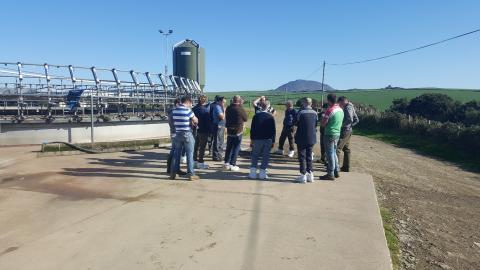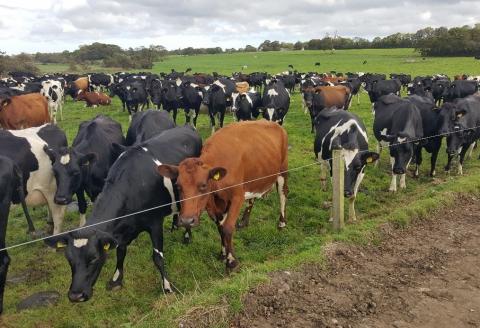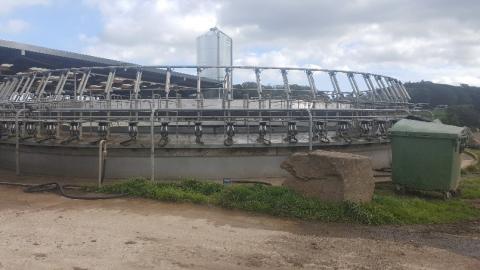Farming Connect Study Visit - Grazing Dragons
Funded through the Knowledge Transfer, Innovation and Advisory Service programme under the Welsh Government Rural Communities – Rural Development Programme 2014 - 2020
Grazing Dragons
Visit to Anglesey and Lleyn
9th - 10th of October 2018
1) Background
Formed in 2000, the Grazing Dragons are a long-established dairy discussion group. The group has approximately 20 members, all of which operate block spring calving systems.
Aims and objectives of the study:
- Gain an understanding of the structure of the different businesses
- Discover how the structure of the businesses incentivise and motivates the individuals involved
- Discover why there has been significant growth within the businesses and what drove this decision
- Discover if the physical and financial performance benchmark is a fair comparison with the group’s own CFP data, considering the differing structure
2) Itinerary
2.1 - Day 1: Mathew Venables & Johnjo Roberts, Anglesey
This was an 800 cow spring calving unit, recently established on a FBT. The grazing platform was 270 ha. Resources on the farm included a 70 point rotary parlour and large feed pad. Cows are off-wintered.
The structure of the business is a 50:50 equity partnership between Mathew Venables & Johnjo Roberts. In addition to the farm visited, the business has another 800 cow unit at the north of the county at Mynachdy farm, which is Johnjo Robert’s home.
Key learning outcomes and knowledge gained:
The group gained an understanding of the working relationship and structure between the two partners, i.e. importance of 50:50 share.
Staff were currently salaried and not incentivised with performance bonuses. However, we were told that incentives may be introduced in the future. Regular staff training was offered including sessions on leadership, workplace psychology, stress management and psychometrics. The purpose of these sessions are to raise awareness within the team of how to work well with others. This training was being delivered by Nollaig Heffernen, an independent management consultant specialising in leadership and organisational psychology.
Both partners made interesting points relating to having good dialogue with staff. This was carried out through a weekly farm walk rather than a structured review. Both stressed the importance of knowing what motivated staff and why they did the job.
2.2 - Day 1: Richard Rogers, Anglesey.
Richard is a former Farming Connect demonstration farm and currently a Farming Connect mentor. Richard switched from beef and sheep production to a spring calving New Zealand style dairy herd in a joint venture with Gethin Roberts and an equity share from Rhys Williams. Bodrida is a 90ha grazing platform carrying 350 NZ crossbred cows. Richard and Gethin have since converted another farm to dairying, this farm being a 60ha platform carrying 240 cows. The group visited both farms.
Key learning outcomes and knowledge gained:
A very tidy farm with good grassland, good cows and a very happy, contented young team.
Richard appeared to be a charismatic farmer, providing Gethin with the opportunity to have equity in the business, together with significant freedom to manage the enterprises. Gethin appeared to know more than Richard about the day to day management, a good sign of delegation!
There was a young team of staff who were positive about having a career in dairying. Staff training was important, with staff members attending ‘mini gogs’ discussion group and undetaken Farming Connect & AHDB training.
They had a full-time general farm worker/skilled trader working on the farm and his role was to complete projects! This appeared to give the business good momentum in getting things done and having a good working environment. There was an emphasis on having a good working environment for staff.
2.3 - Day 2: Matthew Jackson, Pwllheli.
Matthew is a 50/50 share farmer working with Wynne Finch Farms. The enterprise was established in 2014 and currently milking 400 cows. Previous to this, Matthew worked as a herdsperson for Wynne Finch Farms at neighbouring farm Cefnamwlch.
Key learning outcomes and knowledge gained:
Matthew summarised his background and how he was now a share-farmer with Wynne Finch Farms. This was well summarised in graph form showing equity increase over the last 10 years. Details were not included in this summary however the equity growth was significant and inspiring. The equity growth was measured in an annual balance sheet with the equity growth predominantly driven by livestock numbers. Matthew achieved this growth by rearing his own stock outside of the joint venture, together with rearing through contract rearers. The fact that there was no TB in the area helped with the logistics of rearing groups of heifers. The next step for Matthew is a new joint venture with John Furnival (Staffordshire dairy farmer) to convert two recently purchased farms in South Wales to dairying in 2019.
This was a good example of what can be achieved if goals are set and if there is a very strong focus on achieving them.
It was difficult to determine whether this example could be replicated or if it is solely down to the individual character and personality?
2.4 - Day 2: Elgan Davies & Dafydd Wynne Finch, Pwllheli.
Cefnamwlch farm was converted by the farm owner Mr David Wynne-Finch from beef and sheep to dairy in 2003. The farm had a milking platform of 297 ha, a 70 bale Waikato milking parlour and 866 roofless cubicles. They were currently milking 820 cows with youngstock reared off farm. Annual production is at approximately 4.5 million litres.
Key learning outcomes and knowledge gained:
Dafydd Wynne-Finch has always promoted joint ventures and did his Nuffield scholarship on collaboration and people, “profit is great but a profitable relationship is even better”.
The joint venture agreement at Cefnamwlch was based on Dafydd Wynne-Finch owning the land, infrastructure and 75% of the cows and young stock and Elgan and his wife Elena owning 25% of the cows and young stock and receiving 12% of the CFP profit.
The farm had a team of young people working there. The business had never advertised for staff with recruitment being done through word of mouth. There was an emphasis on the development of people and letting them fulfil their ambitions, whatever they may be. Everyone who works on the farm have to visit or work other farming businesses. The business encourages staff to travel and experience different aspects of agriculture e.g. visit or work in New Zealand.
The above was evident with Elgan and Elena moving on from Cefnamwlch to start a new venture of their own on Elena’s parents farm. This being a conversion to dairying, which will start in 2020. Carwyn, who currently works at Cefnamwlch, will progress to manager and be offered the opportunity to have a share in the CFP profit, if he wishes to invest in the business.
The young team (Carwyn, Trystan, Adam and Deio) carry out farm walks on Mondays (split into two groups and walk half the farm) and this was seen as an essential management tool and provided the opportunity for team meetings.
2.5 - Day 2: Rhys Williams, Pwllheli.
Rhys was involved in multiple enterprises, namely:
- Two farms (Pentrefoelas & Trefor, Anglesey) with Dafydd Wynne Finch under the trading name of Padog farms Ltd
- Equity investment in Treifan Ltd
- Joint venture with Robat Griffiths at Wrexham where they run an all year round calving flying herd
- Owner and occupier at Trygan farm, purchased in May 2012.
Key learning outcomes and knowledge gained:
All farms operated simple systems with youngstock away from the platform and additional winter forage stock sourced ‘off farm’. 2018 had been a challenging year for this!
The unit at Wrexham run an all year round calving flying herd, with cows purchased from the ‘other units’ which were out of cycle but young and healthy enough to be replacements. This was a good policy to avoid wastage.
Rhys said that his office was the truck with a mobile phone and access to Agrinet figures. The latter as a method of recording was essential.
Staff and managers on the units were all incentivised through a mix of profit share, cow ownership and opportunity to purchase heifers. This allowed Rhys to operate the system remotely by visiting them once a week.
3) Next Steps
Group to reflect on the following points as a self-awareness exercise:
- Is there good dialogue between staff and business partners within the business?
- What motivates you? Do you know?
- Having good resources will help with staff recruitment, are current resources attractive for staff to work in?
- Are personal and business goals defined?
- Are staff members encouraged to receive additional training and fulfil their ambitions?
- Should a weekly farm walks and meetings with staff be a set routine?
- Could incentivising staff and managers with a small profit share or ownership of cows generate a method of achieving greater performance and profit?



